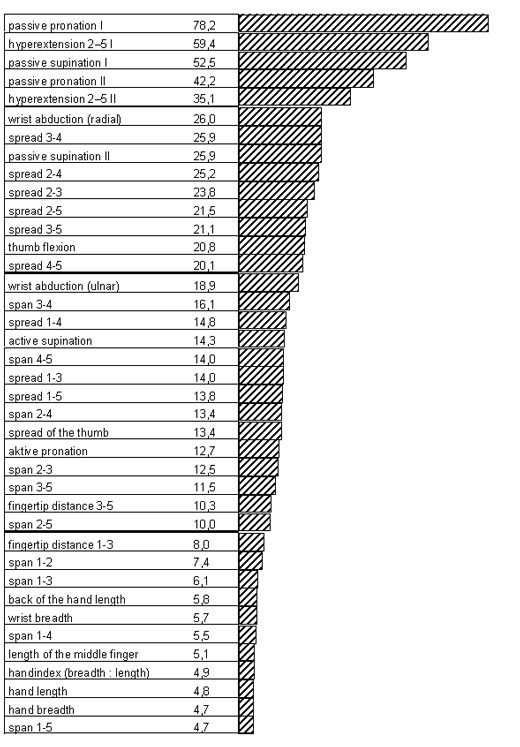| Home |
HAND
und INSTRUMENT |
Reviews |
Christoph Wagner |
Lectures/seminars | Consultation/contact |
 |
|
| Results of measurement
(Examples) |
 |
The coefficient of
variation indicates the size of dispersion of individual values
around their (arithmetic) mean.
The larger this number is, the more frequently we will meet great, sometimes surprising differences between musicians' hands. So, from the start, these numbers direct the practical observation to those characteristics which turn out strongly different. Example The coefficient of the span 1-5 (piano, men, l.h.) amounts to 4,7% which is found at the end of the ranking. The marked differences of the span 1-5 are small in comparison with the differences in other hand characteristics, e.g. - passiv
spread of the thumb (13,4%)
- span 3-4 (16,1%) - flexion of the thumb in the metacarpo-phalangeal joint (20,8%) - wrist abduction towards the thumb side (26,0%) - passive hyperextension I of the metacarpo-phalangeal joints 2-5 (59,4%) |
|
|
| There are corresponding rankings for the
right and left hand of women and men in the groups "piano",
"violin/viola" and "violoncello" as well as "mixed instruments" in
appendix 2, pp. 323-327. Their significance for the practice is
discussed in chapter F. |
span 3-4 (p. 282) smallest and largest measured active span width 3-4 (pianists, l.h. minimum 4,7 cm, maximum 12,0 cm) |
hyperextension of the
carpo-metacarpal
joints 2-5 (p.
318) 60° difference between the smallest and largest measured passiv hyperextension of the metacarpo-phalangeal joints 2-5 (mixed instruments, men, l.h., minimum 0°, maximum 60°, torque 37,5 Ncm) |
pronation (p.
319) 110° difference between the smallest and largest measured passiv pronation (mixed instruments, men, r.h., minimum 5°, maximum 115°, torque 16 Ncm) |
| (1)
number: number
of examined right or left hands of male and female pianists (2) arithmetic mean: The average value of the spans, here remarkably similar in both hands of men and women (3) coefficient of variation: indicator of the extent of the differences between the hands within a group, here with about 15% approximately three times(!) larger as in the case of the span 1-5, i.e. hands are much more different in the span 3-4 than in the span 1-5 Variation coefficients from 5% up to approx. 70% were found at the investigation of the individual hand characteristics (see above)! (4) minimum – maximum: They show the smallest and largest value of the series of measurements. Even if values of this size are extremely rare, one must expect them nevertheless. (5) deciles: Deciles characterize the distribution of the measured values after arranging them according to the increasing size. Under the first decile D1 (men right hand: 62 mm), there are still 10% of the values, which are smaller than 62 mm. Above the ninth decile (D9), there are 10% of the measured values which are still larger than 94 mm. The range between D1 and D9 contains the middle 80% of the values and therefore the largest part of what occurred in the investigation. The advantage of working with deciles is to determine the relative position of any individual value in the corresponding reference group. The decile rows are basis of the "hand profiles“. |
|
| There are appropriate tables for all 39
hand characteristics and for the groups “piano”, “violin/viola” and
“violoncello” as well as “mixed instruments” in appendix 1, p.
278-322. Their significance for practice is discussed in chapter
F. |
|
|
to the top | Copyright 2006/07 Christoph Wagner |